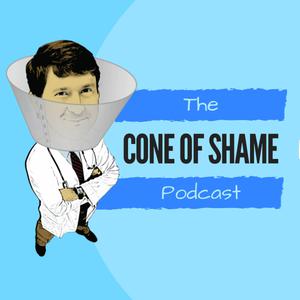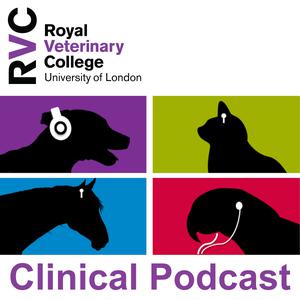
Veterinary ECC Small Talk
Shailen Jasani MA VetMB MRCVS DipACVECC
Small Animal Veterinary Emergency and Critical Care
- 55 minutes 1 secondImproving Patient Care (QI)
In this episode I am joined by my friends and colleagues, Stacey Davidson and Ru Clements of VetLed, to discuss the role of Quality Improvement (QI) in improving patient care.
We discuss what QI is and why you should be engaged with it. We also talk about the role of human factors and workplace culture in QI.
A description of many of the terms used in the episode can be found at the website here.
Apologies for the sometimes crackly sound quality on this episode.
Veterinary Human Factors private Facebook group started by VetLed
1 December 2017, 5:32 pm - 42 minutes 22 secondsSepsis and the Glycocalyx
This episode is focused on sepsis. I also talk about the relevance of the glycocalyx. And emphasise how much extrapolation there is from human medicine to veterinary practice.
Topics covered include:
- Long-standing sepsis definitions and recently suggested updates
- History of sepsis management in human medicine; including early-goal directed therapy and Surviving Sepsis Campaign
- Recent large scale human trials: ProCESS (USA), ARISE (Australasia), ProMISe (UK)
- Key steps for managing the septic veterinary patient
- The glycocalyx: what it is, what it does, why it is relevant, implications for practice
Click Here For Your FREE Copy of a Transcript of This Episode
Click Here for Show Notes To find out more about my Small Animal Emergency Medicine App (iOS, Android) click here.
15 September 2017, 11:42 am - 32 minutes 41 secondsFeline Hypertension
Although feline hypertension may be a rare reason for emergency presentation, it is a condition that most small animal practitioners will have encountered both in routine practice and in critical care patients.
This episode is based on the 2017 ISFM* Consensus Guidelines on the Diagnosis and Management of Hypertension in Cats which were recently published in the Journal of Feline Medicine and Surgery. The episode discusses the following points: [*International Society of Feline Medicine]
- Evidence base behind the Guidelines
- Secondary versus primary hypertension
- Target organ damage
- Monitoring and Underdiagnosis
- Which cats to monitor blood pressure in
- Importance of ensuring blood pressure is measured as accurately as possible with a reproducible technique
- White coat hypertension
- Defining normal blood pressure
- Criteria for therapeutic intervention and appropriate therapeutic targets
- What treatment to use
- Emergency treatment
The episode is based on:
ISFM Consensus Guidelines on the Diagnosis and Management of Hypertension in Cats. J Fel Med Surg 2017. 19:288–303.
Click Here For Your FREE Copy of a Transcript of This Episode
For show notes for this episode, click here.
15 June 2017, 1:59 pm - 40 minutes 50 secondsHepatic Encephalopathy in Dogs and Cats
Hepatic encephalopathy is a relatively common condition in dogs and to a lesser extent in cats. It is a disorder that all clinical veterinary staff, and especially those working in Emergency and Critical Care, should be aware of.
This episode is based on a review article and covers the pathogenesis, clinical presentation, diagnosis, and management of hepatic encephalopathy in dogs and cats including comparisons with human medicine.
The episode is based on:
Lidbury JA, Cook AK, Steiner JM. Hepatic encephalopathy in dogs and cats. J Vet Emerg Crit Care 2016. 26 (4):471-487.
Click Here For Your FREE Copy of a Transcript of This Episode
For episode show notes click here.
For my Small Animal Emergency Medicine App on iOS click here. Android version coming out in early-mid 2017.
3 April 2017, 10:52 am - 27 minutes 27 secondsActivated Charcoal
Activated charcoal is a widely used therapy, especially in dogs, to facilitate gastrointestinal decontamination following toxin ingestion. Points covered in this episode include:
- A reminder about what activated charcoal is and how it is meant to work
- Comments about the use of activated charcoal as a therapy contrasting human and veterinary medicine
- Contraindications and adverse effects
- Timing of administration
Click Here For Your FREE Copy of a Transcript of This Episode
16 December 2016, 8:57 pm - 54 minutes 17 secondsPhysiotherapy in the Critical Veterinary Inpatient
On this episode of the podcast I am joined by Kim Sheader (MSCP HCPC ACPAT Cat A, Chair ACPAT, RAMP), Chartered Veterinary and Human Physiotherapist, to discuss physiotherapy for the critical inpatient. Kim is a highly qualified and experienced physiotherapist and currently works with The Ralph Mobile Physiotherapy & Rehabilitation service.
I start by finding out about Kim’s background, training and experience in human and more recently veterinary physiotherapy. We then go on to discuss:
- Physiotherapy for the critical patient with prolonged recumbency
- Physiotherapy for the dog with moderate-to-severe tetanus
- Respiratory physiotherapy, a subject about which Kim is especially passionate
To contact Kim please email her at [email protected] or message her via The Ralph MPRS website www.theralphphysio.vet.
29 September 2016, 10:54 pm - 57 minutes 58 secondsDog and Cat Amputees: 'Tripods'
On this episode of the podcast I am joined by Rene Agredano and Jim Nelson of Tripawds, “the world's largest support community for animal amputees”, to discuss how we as veterinary staff can be better prepared to help clients with dogs and cats that are either facing or have had a limb amputation.
After some background discussion of the Tripawds resource, we discuss:
- Ethical and moral considerations carers may have around amputation
- Steps carers can take to prepare for their amputee dog or cat returning home for the first time
- Client concerns about when their pet will be normal again, pain management, and the surgical incision
The following links were mentioned in the episode:
Tripawds - Help For Three Legged Dogs And Cats
The Tripawds charitable foundation
The PBS Show that Rene mentions, “Why we love dogs and cats”
The Tripawds blog by an ECC vet: Hank the Tank (backstory for Hank the Tank)
4 August 2016, 6:05 pm - 40 minutes 16 secondsA Journal of Veterinary Emergency and Critical Care Papers Episode
Anaemia in critically ill cats; severe anaemia in blocked tomcats; spinal shock in dogs; haemorrhagic GI disease in veterinary ICUs. In this episode of the podcast I discuss a few papers from the latest issue of the Journal of Veterinary Emergency and Critical Care (JVECC) that especially caught my eye, in particular as they relate to primary care practice and not just referral centres.
The four papers in question are:
- Balakrishnan A, Drobatz KJ, Reineke EL. Development of anemia, phlebotomy practices, and blood transfusion requirements in 45 critically ill cats (2009–2011). J Vet Emerg Crit Care 2016. 26(3):406-411.
- Beer KS, Drobatz KJ. Severe anemia in cats with urethral obstruction: 17 cases (2002–2011). J Vet Emerg Crit Care 2016. 26(3):393-397.
- Full AM, Barnes Heller HL, Mercier M. Prevalence, clinical presentation, prognosis, and outcome of 17 dogs with spinal shock and acute thoracolumbar spinal cord disease. J Vet Emerg Crit Care 2016. 26(3): 412–418.
- Swann JW, Maunder CL, Roberts E, et al. Prevalence and risk factors for development of hemorrhagic gastro-intestinal disease in veterinary intensive care units in the United Kingdom. J Vet Emerg Crit Care 2016. 26(3): 419–427.
Remember as always that what I don’t tend to do in these podcasts is to provide an in-depth evidence-based appraisal of the papers I mention. So I continue to encourage you to get in touch for copies of the papers if you do not have access to JVECC and to read and critique the papers yourself. Don’t just take what the abstract says or indeed what I say here at face value!
Click Here For Your FREE Copy of a Transcript of This Episode For SHOW NOTES for this episode click here. And be sure to check out the Veterinary Small Animal Emergency Medicine App.
23 June 2016, 9:53 am - 40 minutes 43 secondsAntimicrobial Stewardship in Companion Animal Practice
Antimicrobial resistance is said to be one of the greatest challenges currently facing small animal veterinary medicine. How can we become part of the solution rather than part of the problem?
In this episode of the podcast I start by providing a brief refresher of bacteriology and antibacterials before going on to discuss antimicrobial stewardship in an episode that is derived from this review article:
Guardabassi L, Prescott JF. Antimicrobial Stewardship in Small Animal Veterinary Practice: From Theory to Practice. Vet Clin N Am – Sm Anim Prac 2015. 45(2):361–376.
Areas covered include:
- Defining the problem
- What is antimicrobial stewardship?
- Antimicrobial stewardship strategies
- Developing and implementing guidelines
- General (generic) guidelines for rational antibiotic use
- Role of the microbiology laboratory
Click here for SHOW NOTES for this episode.
Click Here For Your FREE Copy of a Transcript of This Episode
And be sure to check out the Veterinary Small Animal Emergency Medicine App.
22 April 2016, 3:16 pm - 1 hour 8 minutesEmotional Well-being in Veterinary Practice
In this episode of the podcast I am joined by Enid Traisman M.S.W., CT, CFS to discuss issues around emotional well-being in veterinary practice.
Enid is the Director of Pet Loss Support Services at Dove Lewis, a non-profit emergency animal hospital in Portland, Oregon in the USA.
Topics that we discuss in this episode include the following; where appropriate we talk about prevention, recognition and coping strategies:
- Pet loss grief
- When veterinary staff have to deal with loss of their own companion animals
- Compassion fatigue and burnout
- Workplace stress and emotional challenges of the veterinary profession
During the episode Enid mentions creating a memorial table at work when a staff member loses a pet. You can find Enid’s overview of the pet memorial table concept and a list of other REALLY USEFUL RESOURCES, both provided by Enid and some others, HERE.
Find contact details for Enid here on the Dove Lewis website.
And don’t forget to check out the Small Animal Emergency Medicine app for iOS devices here. Android version to follow soon!
6 March 2016, 8:23 pm - 30 minutes 47 secondsWhat's Magnesium Got To Do With It?
In this episode of the podcast I take a look at magnesium and its role in clinical practice, something which many people may not be very familiar with. The episode is based on the following article:
Humphrey S, Kirby R, Rudloff E. Magnesium physiology and clinical therapy in veterinary critical care. J Vet Emerg Crit Care 2015.
- Areas covered include:
- Background theory
- Measuring magnesium
- Magnesium disorders
- Treatment
Click Here For Your FREE Copy of a Transcript of This Episode
For SHOW NOTES for this episode see Here.
And don't forget to check out my Small Animal Emergency Medicine App - currently for iPhone and iPad; Android version out soon!
5 February 2016, 7:50 pm - More Episodes? Get the App
Your feedback is valuable to us. Should you encounter any bugs, glitches, lack of functionality or other problems, please email us on [email protected] or join Moon.FM Telegram Group where you can talk directly to the dev team who are happy to answer any queries.
 VetFolio Voice
VetFolio Voice
 Clinician's Brief: The Podcast
Clinician's Brief: The Podcast
 The Cone of Shame Veterinary Podcast
The Cone of Shame Veterinary Podcast
 Veterinary Clinical Podcasts
Veterinary Clinical Podcasts
 VETgirl Veterinary Continuing Education Podcasts
VETgirl Veterinary Continuing Education Podcasts